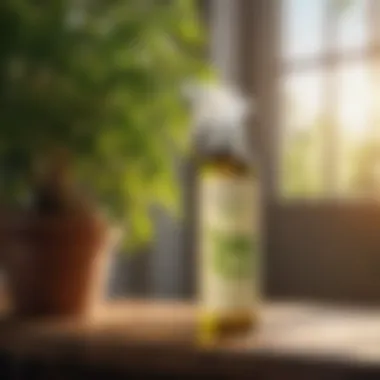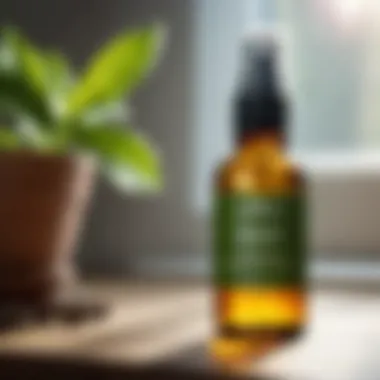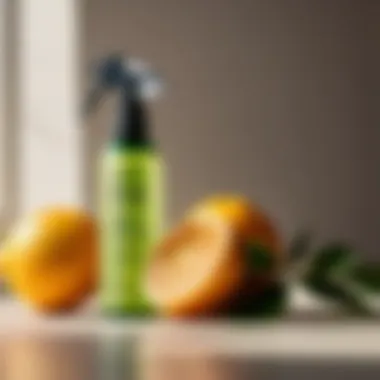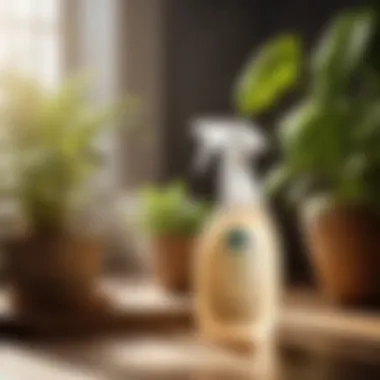Discover the Best Safe Bug Spray Options for Indoor Plants to Ensure a Healthy Environment


Materials:
- 32 oz spray bottle
- Neem oil (2 tablespoons)
- Liquid dish soap (1 tablespoon)
- Warm water (1 cup)
- Measuring spoons
DIY Steps:
- Prepare Ingredients: Gather a 32 oz spray bottle, neem oil, liquid dish soap, warm water, and measuring spoons.
- Mix Solution: In the spray bottle, combine 2 tablespoons of neem oil and 1 tablespoon of liquid dish soap.
- Add Water: Fill the bottle with 1 cup of warm water.
- Shake Well: Secure the bottle cap tightly and shake the mixture thoroughly to ensure all ingredients are blended.
- Application: Spray the solution on affected plant areas, focusing on pests and undersides of leaves.
Technical Aspects:
- Tools: 32 oz spray bottle, measuring spoons
- Timing: Takes approximately 5 minutes to prepare and apply
- Techniques: Ensure thorough shaking for proper emulsification of ingredients
DIY Project Process:
- Sequential Steps: The process involves simple mixing and application steps.
- Troubleshooting Tips: If the spray clogs, dilute with more warm water and shake again until the consistency is right.
Introduction
Indoor plants not only add aesthetic value to our homes but also contribute to a healthier indoor environment by purifying the air and reducing stress levels. However, along with the numerous benefits of having indoor plants comes the inevitable risk of pests infesting our green companions. This is where the importance of safe bug sprays for indoor plants becomes paramount.
In this article, we delve into the essential role that safe bug sprays play in maintaining the health and vitality of indoor plants. We will explore the reasons why opting for non-toxic bug sprays is crucial for sustaining a harmonious ecosystem within our indoor spaces. By understanding the significance of using safe alternatives, housewives and homeowners can effectively protect their beloved plants without compromising on safety or plant health.
The discussion will revolve around various elements such as the adverse effects of chemical bug sprays on both plants and human health, the increasing awareness of eco-friendly pest control solutions, and the benefits of opting for natural bug sprays. By shedding light on these specific elements, readers will gain a comprehensive understanding of why safe bug sprays are the ideal choice for indoor plant enthusiasts seeking to maintain a green haven within their homes.
Furthermore, we will address practical considerations like the ease of use, affordability, and availability of safe bug sprays in the market. This section will provide insights into the convenience and accessibility of natural bug spray options, ensuring that readers are well-informed and empowered to make the best choices for their indoor plants. Through a detailed examination of these considerations, readers will be equipped with the knowledge needed to effectively combat pests while fostering a thriving indoor garden.
Ultimately, this introduction sets the stage for an in-depth exploration of safe bug sprays for indoor plants, emphasizing the critical role they play in promoting plant health, environmental sustainability, and human well-being. By the end of this article, readers will be well-versed in the importance of choosing non-toxic alternatives to protect their indoor plant companions and nurture a flourishing botanical sanctuary within their homes.


Why Choose Safe Bug Sprays?
In this comprehensive guide to safe bug sprays for indoor plants, the significance of choosing safer alternatives over traditional chemical pesticides cannot be overstated. When considering why to opt for safe bug sprays, several key elements come into play that align with the overarching goal of maintaining a healthy and eco-friendly environment within your home.
One of the primary reasons to choose safe bug sprays is the potential harm that chemical-based pesticides can pose to not only the targeted pests but also to the plants themselves. Chemical bug sprays often contain harsh ingredients that can harm the natural balance of your indoor plant ecosystem, leading to long-term damage and weakened plant health. By transitioning to safer alternatives, you ensure that your plants are protected from harmful chemicals, promoting their overall growth and vitality.
Moreover, safe bug sprays offer a more sustainable and environmentally conscious approach to pest management. Traditional pesticides can have detrimental effects on the environment, contaminating soil and water sources, and impacting beneficial insects crucial for a balanced ecosystem. Opting for safe bug sprays allows you to combat pests effectively while minimizing your carbon footprint and contributing to a greener planet.
Another compelling reason to choose non-toxic bug sprays is the health benefits they provide for you and your family. Chemical pesticides carry potential health risks, including respiratory issues, skin irritation, and long-term health concerns from repeated exposure. Safe alternatives derived from natural ingredients offer a safer solution, reducing the risk of indoor air pollution and ensuring a healthier living space for everyone in your household.
In essence, the decision to choose safe bug sprays extends beyond simple pest control - it reflects a commitment to plant health, environmental stewardship, and the well-being of those who share your home. By understanding the specific benefits and considerations associated with opting for safer alternatives, you empower yourself to create a thriving indoor garden while upholding sustainable practices that benefit both your plants and the planet.
Common Pests in Indoor Plants
In the realm of indoor plants, the presence of pests can be a significant concern for plant enthusiasts. Common pests such as aphids, spider mites, and fungus gnats not only pose a threat to the health and vitality of indoor plants but can also disrupt the overall balance of your indoor garden ecosystem. Understanding these common pests and their impact is crucial in effectively managing and protecting your beloved plants.
Aphids
Aphids, also known as greenflies or blackflies, are tiny insects that feed on plant sap. They reproduce rapidly and can cause significant damage to indoor plants by weakening them and causing deformities in leaves and stems. These pests are often found clustered on new growth or the undersides of leaves. To address an aphid infestation, it is essential to use safe bug sprays that target and eliminate these pests without harming the plants or introducing harmful chemicals into your indoor space.
When dealing with aphids, utilizing natural remedies like neem oil or insecticidal soap can be effective in controlling their population and preventing further damage to your plants. Regular monitoring and early intervention are key to managing aphids and maintaining the health of your indoor garden.
Spider Mites
Spider mites are another common pest that can wreak havoc on indoor plants. These tiny arachnids feed on plant sap, causing stippling, yellowing, and ultimately the death of leaves. Spider mites thrive in dry, hot conditions, making indoor environments conducive to their proliferation. Identifying spider mites early on is crucial to preventing widespread infestations and preserving the aesthetics and health of your plants.
Combatting spider mites requires the use of safe bug sprays that specifically target these pests. Neem oil, essential oils, or insecticidal soap are effective options for controlling spider mite populations while ensuring the well-being of your indoor plants. Regularly inspecting your plants, particularly the undersides of leaves where spider mites often reside, can aid in early detection and prompt action against these troublesome pests.
Fungus Gnats


Fungus gnats are small, flying insects that lay their eggs in moist soil. The larvae of these pests feed on plant roots, impeding the uptake of nutrients and water, leading to stunted growth and poor plant health. Fungus gnats are commonly attracted to overwatered indoor plants or organic matter in soil, making proper watering practices and soil maintenance essential in preventing infestations.
To combat fungus gnats effectively, it is vital to use safe bug sprays that target both the adult gnats and their larvae. Neem oil and insecticidal soap can help control fungus gnat populations while ensuring the overall health of your indoor plants. Additionally, employing strategies like allowing the soil to dry out between waterings and using sticky traps can aid in managing and reducing fungus gnat populations in your indoor garden.
Dangers of Chemical Bug Sprays
When it comes to maintaining the health and aesthetics of indoor plants, the use of bug sprays is often necessary to combat pesky pests. However, the convenience of chemical bug sprays comes with significant drawbacks that cannot be overlooked. Understanding the dangers associated with these chemical solutions is crucial for ensuring the well-being of both your plants and household members.
Chemical bug sprays contain toxic ingredients that can have detrimental effects on plant health. The pesticides present in these sprays are designed to be lethal to pests, but they can also harm beneficial insects, such as pollinators, and disrupt the natural balance of your indoor garden ecosystem. Additionally, prolonged exposure to these chemicals can lead to plant stress, stunted growth, discoloration, and even plant death.
Furthermore, the impact of chemical bug sprays extends beyond plant life. These toxic substances pose significant risks to human health and the environment. Inhalation or skin contact with chemical pesticides can trigger allergic reactions, respiratory issues, and skin irritation. Moreover, the runoff from these sprays can contaminate water sources, harm other wildlife, and contribute to environmental pollution.
Considering these dangers, transitioning away from chemical bug sprays is not only a matter of plant health but also a crucial step towards creating a safer, more sustainable indoor gardening practice. By opting for safer alternatives, you can protect your plants, loved ones, and the environment from the harmful effects of chemical pesticides.
Safe Alternatives to Chemical Bug Sprays
In the realm of indoor plant care, combatting pests while safeguarding the environment and inhabitants within a household is a concern that cannot be overlooked. As we navigate the landscape of pest control, seeking safe alternatives to chemical bug sprays becomes paramount. This section aims to delve into the significance of selecting non-toxic solutions for pest management, focusing on the specific elements, benefits, and considerations regarding safe alternatives to chemical bug sprays.
When we consider the importance of safe alternatives to chemical bug sprays within the context of this article, we are prompted to rethink traditional pest control methods that may pose risks to plants and individuals. By exploring natural remedies that are both effective against pests and benign towards plant health and human well-being, we transcend the limitations of conventional insecticides.
The transition towards safe alternatives signals a shift towards sustainable and eco-conscious practices within the realm of indoor gardening. By opting for non-chemical solutions, we reduce the systemic impact on the environment while promoting a healthier setting for plant growth. This consideration goes beyond mere pest control; it underscores a holistic approach to nurturing indoor greenery.
An essential aspect to consider when exploring safe alternatives to chemical bug sprays is the inherent gentleness and compatibility of these solutions with indoor plants. Unlike their chemical counterparts, non-toxic alternatives such as neem oil, essential oils, and insecticidal soap offer targeted pest control without compromising the vitality of plants. This tailored approach not only eliminates pests but also nurtures the overall well-being of indoor greenery.
DIY Bug Spray Recipes
In the realm of safe bug sprays for indoor plants, DIY bug spray recipes hold a significant appeal for those looking to take a more hands-on approach to pest control. These homemade alternatives offer a natural, non-toxic solution that is both effective and environmentally friendly. DIY bug sprays provide housewives and homeowners with the satisfaction of knowing exactly what ingredients are being used around their beloved plants.
One of the key benefits of DIY bug spray recipes is the ability to customize the formula to suit specific plant needs and pest infestations. By utilizing common household ingredients like vinegar, dish soap, or essential oils, individuals can create a tailored bug spray that targets pests while being gentle on plants. This personalized approach ensures that the spray is not only effective but also safe for indoor plant health.


Furthermore, DIY bug sprays are cost-effective alternatives to commercial products, saving money in the long run. Housewives and homeowners can create bug sprays in small batches as needed, reducing waste and ensuring freshness. Additionally, the simplicity of DIY recipes makes them accessible to all skill levels, allowing beginners to venture into natural pest control without intimidation.
When delving into DIY bug spray recipes, it's essential to consider the specific ingredients and their interactions with different plant species. Some plants may be more sensitive to certain components, emphasizing the need for research and cautious experimentation. Understanding the efficacy of ingredients like neem oil or peppermint essential oil can help individuals formulate bug sprays that strike a balance between potency and plant safety.
Housewives and house owners seeking a deeper connection with their indoor plants can find satisfaction in creating DIY bug sprays that not only protect greenery from pests but also contribute to a healthier home environment. These homemade concoctions inject a sense of creativity and care into pest management, fostering a bond between caregiver and plant that goes beyond mere maintenance. Embracing the world of DIY bug spray recipes opens up a realm of possibilities for eco-conscious individuals looking to nurture their indoor plant oasis.
Application Tips for Safe Bug Sprays
When it comes to safeguarding indoor plants from pesky insects, understanding the nuances of applying safe bug sprays is paramount to their efficiency and plant safety. Implementing effective application tips ensures a thorough and successful pest control regimen that is gentle yet potent in combatting infestations.
Importance of Proper Application
The crux of utilizing safe bug sprays lies in how well they are applied to the plants. Correct application techniques not only guarantee optimal pest eradication but also mitigate the risk of damaging the plant foliage or compromising its health. By focusing on application tips, one can ensure maximum efficacy of the bug spray while maintaining a safe environment for both plants and inhabitants.
Benefits of Following Application Tips
Following specific application tips offers a plethora of benefits, including targeted pest control, minimal waste, and enhanced plant protection. By adhering to recommended application methods, users can precisely target affected areas, minimizing the usage of bug spray and reducing the chances of overexposure. Additionally, proper application safeguards plants from potential harm, ensuring their longevity and vitality.
Considerations for Effective Application
Several factors play a vital role in ensuring the successful application of safe bug sprays on indoor plants. Considerations such as timing, weather conditions, and correct dosage are instrumental in achieving desired results. Timing application during non-peak sunlight hours and ensuring the absence of rain can optimize the bug spray's absorption into the plant while preventing it from being washed away. Moreover, adhering to recommended dosage levels prevents the risk of overapplication, safeguarding both plant health and indoor air quality.
In summary, mastering the art of applying safe bug sprays is indispensable for maintaining a pest-free indoor garden. By understanding the significance of proper application, recognizing the benefits it offers, and considering essential factors, individuals can effectively combat pests while upholding a safe and healthy indoor environment.
Conclusion
In the realm of indoor plant care, the utilization of safe bug sprays holds paramount importance. As discussed throughout this comprehensive guide, the well-being of indoor plants is intricately linked to using bug sprays that are not only effective in pest control but also safe for the plants themselves and for the individuals inhabiting the space. The conclusion serves as a pivotal point underscoring the significance of opting for safe bug sprays when combatting indoor plant pests.
One of the key benefits emphasized in this article is the preservation of plant health. Safe bug sprays ensure that while pests are being eradicated, the integrity and vitality of the plants remain intact. This is crucial for housewives and homeowners invested in maintaining lush, thriving indoor gardens. By choosing non-toxic options, they are safeguarding the well-being of their green companions.
Moreover, another crucial consideration about safe bug sprays is their eco-friendliness. In a world increasingly conscious of environmental impact, the use of products that do not contribute to chemical pollution is a responsible choice. Safe bug sprays provide an effective solution without harming the ecosystem or posing risks to beneficial insects.
Furthermore, this conclusion sheds light on the long-term efficacy of safe bug sprays in pest management. While chemical alternatives may offer quick fixes, the repercussions can be detrimental. By adopting safe bug sprays, individuals can create a sustainable pest control strategy that mitigates risks of resistance development and aids in maintaining a balanced indoor plant ecosystem.
In essence, this guide's conclusion is a call to action for housewives and homeowners to prioritize the use of safe bug sprays for indoor plants. The benefits of plant health preservation, eco-friendly practices, and sustainable pest management make a compelling case for embracing non-toxic alternatives. By making informed choices and investing in the well-being of indoor plants, individuals can create harmonious spaces that thrive with green vitality.







